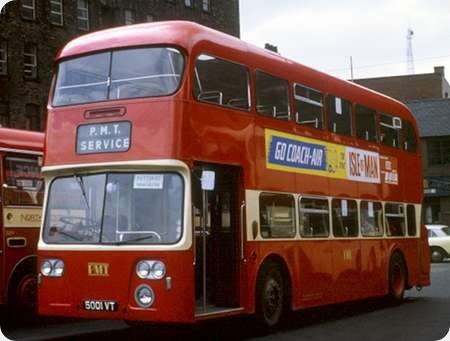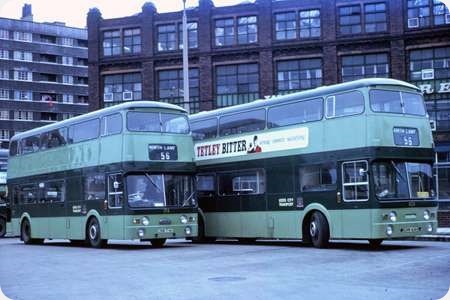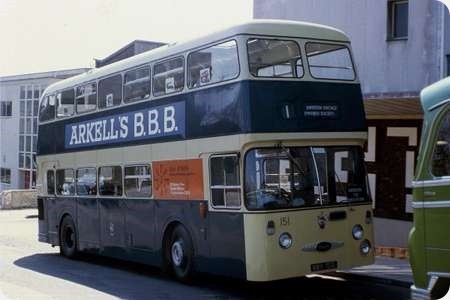
Potteries Motor Traction
1964
Daimler Fleetline CRG6LX
Alexander H41/31F
Photographed in June 1970 at Manchester, and mercifully still retaining its Potteries livery and logo,
is Daimler CRG6LX Fleetline No. L 1001, 5001 VT, with Alexander H41/31F bodywork, the first of a batch
of twenty five delivered in April 1964. Ten similar vehicles followed in 1965. L 1001 seems to be
remarkably coy about showing its destination, reducing its passenger information down to a sticker in
the windscreen. Was this route not a standard operation for this type of vehicle, which would not then
have had Manchester on its blind display?
Photograph and Copy contributed by Roger Cox
17/03/19 - 09:11
Yes Roger,
It should be able to show ‘Manchester’ in the top half
of the box (where it reads P.M.T.) and the second line would show X2 in Bold, with Knutsford over
Altrincham (where it shows ‘Service’) There are photos on the web of the PD3’s that used to
run this service and I have downloaded a copy of Fleetline 964 from the web in exactly the same
place showing the full service blind that I refer to.The layover seemed to be quite lengthy and in
busy times, the vehicle would have to vacate the stand and park on Lower Mosley Street itself, prior
to returning to load up for the return journey. I spent many hours in my spotting days here but
sadly I never got to ride on the service, principally as it was an out and back service TO
Manchester. These Alexander bodied Fleetlines did not look out of place here as they were look
alikes of North Westerns own examples and when PMT provided an NCME bodied Fleetline, of course that
resembled LUT’s which used LMS on the Blackpool service, as all had a basic Red/Cream livery.
Mike Norris
18/03/19 - 07:08
North Western’s Fleetlines had single piece curved windscreens, single
headlamps and different sidelights and the NWRCC colour scheme with a lighter red and more cream was
much less drab. PMT’s colours on its double decker fleet didn’t exactly brighten up the Potteries’
landscape.
Phil Blinkhorn
20/03/19 - 06:15
The PMT vehicles often parked in Whitworth Street West. This road was close to
LMS and was between the two railway lines that ran from the old Central Station and the line from
Oxford Road. In my spotting days the low bridge Atlanteans were common fare.
Andrew Gosling
20/03/19 - 06:16
The ABC Coach and Bus Guide for the Winter period 1969/1970 contains a
timetable for the Potteries to Manchester PMT service X2. Points served were Newcastle-under-Lyme,
Hanley, Burslem, Tunstall, Kidsgrove, Lawton Arms, Sandbach, Holmes Chapel and Knutsford. Set downs
were at Altrincham, Sale, Stretford and Manchester (Lower Mosley Street). (A full fare table was not
shown.
The timetable shows ‘dep’ for departure times up to and including Lawton Arms and
‘arr’ for arrival times at Altrincham and beyond. However, Sandbach, Holmes Chapel and Knutsford
have neither ‘dep’ or ‘arr’ which may mean they could have been both pick-up and set down points).
The northbound departure times were:
09:20 from Newcastle-under-Lyme (arriving
Manchester 11:30) on Saturdays and Sundays
14:30 from Hanley (arriving Manchester 16:30) on
Fridays and Saturdays
The southbound departure times were:
12:00 from Manchester
(arriving Hanley 14:00) on Saturdays
18:00 from Manchester (arriving Newcastle-under-Lyme
20:10) on Fridays, Saturdays and Sundays
PMT also ran a Hanley to Birmingham service X1 which
had a similar format timetable.
David Slater
21/03/19 - 06:58
Bury also had some Alexander Fleet lines, 117 to 131, later 6317-31, but they
had flat windscreens and were the full height version.
David Pomfret
26/03/19 - 06:53
David Slater’s description of the timetable is very helpful. Was it really the
case that passengers were only allowed 30 minutes to spend in the city of Manchester.
Barely
time to purchase a cup of tea and an Eccles Cake!
Petras409
02/07/19 - 05:59
L1001. 5001 VT was allocated to Newcastle Garage and service X2 was operated
by Hanley Garage it may have been the case that ‘Manchester’ was not on the destination blind.
Out of interest the bus was destroyed by a fire at Newcastle Garage in 1975.
Leekensian
12/02/20 - 16:38
On a matter related to P.M.T double deck Fleetlines, I recall travelling on
Burslem based Northern Counties bodied L967 and noted that the electronic gear shift had been
replaced by a floor mounted air assisted unit. If my memory serves me right I cannot recall ever
coming across this feature on any other P.M.T. Fleetline. There must have been a reason for this
change - I just wonder what it was.
Leekensian
23/02/20 - 09:43
In the early days of semi automatic gearboxes - Fleetline, Atlantean etc - PMT
had concerns over the reliability of the ep (electro-pneumatic) valves which actuated the air supply
to the different gear ratios. As early as 1957, the prototype PD3 (PMT H7700) had a direct air
change from a floor mounted pedestal. On the early Fleetline in particular where the ep valve was
mounted on the gearbox bell housing this was vulnerable to serious damage in the (not infrequent)
failure of the trailing link coupling between the engine and transmission. This was moved under the
lower deck rear seat on later variants of the Fleetline. Just how suspicious PMT were of
electro-pneumatic control was evidenced by the removal and blanking off of the neutral warning light
on the gearswitch in the cab on the AtlanteansWWG8. I was not aware of this happening with other
Operators. Another thought is that the production Roadliners 1965 onwards all had direct air
operation from a floor mounted column - the prototype (PMT SN1000 had an ep type gear change). Was
the modification on L967 a precursor to the Roadliners? Finally, PMT took 21 single deck Fleetlines
in 1970 which had the latest Westinghouse miniaturised direct air gear shift mounted on the steering
column. These gave a lot of early trouble where oil in the air pipes caused delay in releasing a
gear and effectively had the bus trying to drive in 2 gears for a brief but disconcerting period.
Daimler solved this by fitting quick release valves at the gearbox end of each gear air pipe.
Ian Wild
23/02/20 - 16:33
Thanks for your input on Fleetline gear controls. I was aware of the Leyland
Pedestal mounted EP’s as Bolton had them on PD2’s and PD3’s. But I am still puzzled about any air
change device on Daimlers (there is thread open on the other webpage) I fully understand your
comments about the coupling between the 6LX and the Gearbox on Fleetlines, having broken one myself,
inadvertently. I was driving LUT Fleetline 184 on service 14 towards New Bury along Bolton Road in
Farnworth, a fairly wide road. I was accelerating from a stop and while in third gear needed to pull
out to pass a parked van. Indicating this manoeuvre, I became aware of a fairly fast car overtaking
me, so came off the accelerator, but then seeing the car flash me to pull out, I re-applied my foot
onto the pedal - Bang ! Disaster ! - bits of the coupling came through the bonnet housing, and more
were embedded in the engine housing behind the rear seat. I received a caution for poor driving but
that was later rescinded when the T&GWU represented me at a disciplinary hearing as the fault became
more widely known about. Yes, the later FEGR Fleetlines had a small lever in a mini pneumocyclic
style gear change that was mounted on the cab offside (not true Fleetlines though).
So still
learning about Fleetlines all these years later, but still believe that electric control was better
than air, for the reasons you have stated.
Mike Norris
25/02/20 - 05:49
In reply to Ian, the conversion could have been a precursor to the Roadliners
but given that L967 was a 1963 delivery would the Engineering Department at PMT have made the
conversion to such a new bus?
Leekensian
29/02/20 - 06:56



